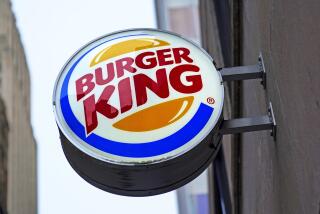âLightâ Smokes Are Latest Legal Target
Over the last three decades, cigarette makers have stemmed the loss of customers by promoting low-tar, or âlight,â cigarettes, enabling countless smokers to switch brands rather than quit. But the savvy marketing strategy has triggered a recent surge of legal and regulatory attacks on the tobacco industry worldwide.
The companies stand accused of promoting the illusion that light brands mean less intake of tar, the soup of cancer-causing compounds in tobacco smoke. Tobacco officials deny deceiving anyone.
But a jury in Portland, Ore., last week dealt the industry its first defeat in a case focused on the marketing of light cigarettes--hitting Philip Morris Cos. with a $150-million punitive damages verdict. Light-cigarette class actions are pending in nearly a dozen states, including California, and soon will be filed in others.
Brazil recently banned use of the words âmild,â âlightâ and âultra-lightâ on cigarette packages and ads, on grounds the terms are inherently misleading. The European Union has voted for similar restrictions, though it remains for member nations to ratify them. Canadian authorities are weighing a ban on the terms, and many nations are seeking to include a similar prohibition in the Framework Convention on Tobacco Control, the global tobacco treaty being negotiated under the auspices of the World Health Organization.
In recent court papers, the U.S. Justice Department said banning the terms is one of the goals of its multibillion-dollar racketeering suit against the tobacco industry.
At issue are the tar and nicotine numbers that appear in cigarette ads--and the industryâs failure to acknowledge, until recently, that smokers often inhale much more tar than do the smoking machines that generate the numbers. Research by industry and independent scientists has shown that after switching to lights, smokers continue to regulate their nicotine dose by drawing deeper, inhaling more often and even blocking with their fingers the air dilution holes in cigarette filters.
As a result of this pattern, known as compensation, the theoretical benefits of lower-tar cigarettes are reduced or eliminated.
A 1975 Philip Morris memo, provided to jurors in the Oregon case, shows that cigarette makers have known this for a long time.
Summarizing tests in which smokers puffed regular Marlboros as well as Marlboro Lights, the memo said smokers of the light cigarettes inhaled deeper and more often and therefore âdid not achieve any reduction in smoke intake by smoking a cigarette ... normally considered lower in delivery.â These findings, the memo said, were âin agreement withâ previous tests.
In a major report on light cigarettes issued in November, the National Cancer Institute said the steady decline in tar yields in the average cigarette has had âlittle meaning for the smoker,â because of the difference in the way machines and people smoke.
âThe reality that many smokers chose these products as an alternative to cessation ... makes this deception an urgent public health issue,â the report said.
Tobacco companies began rolling out âlow-deliveryâ brands about 30 years ago, and âlightsâ--cigarettes with machine-measured tar yields of 15 milligrams or less--now have a market share of about 87%, according to the U.S. Office on Smoking and Health. Like a number of other brands, the countryâs top-selling smoke, Marlboro Lights, has the low-tar designation embedded in its name.
But the introduction of light brands merely accelerated a trend that began in the 1950s, when filtered cigarettes were launched in response to the first cancer scare. During the last 50 years, machine-measured tar yields have declined more than 60%.
As cigarette makers are quick to point out, health authorities were firmly behind this trend.
In 1981, for example, the annual Surgeon Generalâs report called on smokers to switch to low-tar brands if they would not or could not quit.
At the time, health authorities were aware that compensation could occur in the switch from harsher to lighter-tasting brands. But they say they did not grasp the extent of this--nor comprehend the addictive power of nicotine--until millions of internal industry documents were disclosed in recent years.
But even staunch tobacco foes say there is blame to go around. The Federal Trade Commission adopted the official machine-test method in the 1960s to standardize tar and nicotine measurements. Over the years, the FTC was warned the results could be misleading, including by the industry.
âThere is absolutely no excuse for the FTC not to have taken action in some fashion,â said Judith Wilkenfeld, a former FTC official who now is director of international programs for the Campaign for Tobacco-Free Kids, an anti-smoking group in Washington.
The agency âshould long ago have taken its imprimatur off the test methodologyâ or else required the industry to tell consumers in ads âthat these numbers were misleading,â Wilkenfeld said.
Since 1997, the FTC, in consultation with the Department of Health and Human Services, has been trying to revise the test method.
During the last couple of years, tobacco companies have begun putting information about the compensation phenomenon on their Web sites. Two of the three top U.S. manufacturers--Philip Morris and Brown & Williamson Tobacco Corp.--also print a small disclaimer in their ads, noting that tar and nicotine intake vary with the way people smoke.
The companies say the attacks are groundless.
âThose cigarettes were never advertised as being safeâ and come with the same health warnings as all other brands, said William Ohlemeyer, a Philip Morris vice president and associate general counsel.
The Portland jury found these arguments unpersuasive, ordering Philip Morris to pay $168,000 in compensatory damages and $150million in punitive damages.
The case was brought by the family of Michelle Schwarz, who smoked Philip Morrisâ low-tar Merit brand before dying of lung cancer at the age of 53.
Since the punitive damages award was nearly 900 times greater than actual damages, the trial judge is likely to pare the amount, and Philip Morris has vowed to appeal.
Despite the outcome, itâs unclear whether the case represents a major new area of legal vulnerability for the industry. Last year, Brown & Williamson won a similar light-cigarette case in South Carolina.
Still, light-cigarette class actions are popping up across the country--with cases now on file in Illinois, Massachusetts, Florida, New Jersey, Ohio, West Virginia, Tennessee, Missouri, Minnesota and in Alameda County Superior Court in Oakland, where a case was filed against Philip Morris on Oct. 31. So far, courts in three of the states have certified the cases as class actions. Steve Sheller, a Pennsylvania attorney involved in the cases, said additional claims soon will be filed in Utah, Kansas, New Hampshire and Vermont.
The suits have been filed under state consumer protection laws and seek reimbursement for billions of dollars spent on light cigarettes. According to plaintiffsâ lawyers, people should get their money back because cigarette makers deceived them about the actual tar deliveries of the cigarettes.
More to Read
Sign up for Essential California
The most important California stories and recommendations in your inbox every morning.
You may occasionally receive promotional content from the Los Angeles Times.










